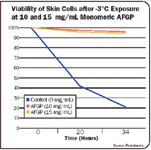- Acne
- Actinic Keratosis
- Aesthetics
- Alopecia
- Atopic Dermatitis
- Buy-and-Bill
- COVID-19
- Case-Based Roundtable
- Chronic Hand Eczema
- Chronic Spontaneous Urticaria
- Drug Watch
- Eczema
- General Dermatology
- Hidradenitis Suppurativa
- Melasma
- NP and PA
- Pediatric Dermatology
- Pigmentary Disorders
- Practice Management
- Precision Medicine and Biologics
- Prurigo Nodularis
- Psoriasis
- Psoriatic Arthritis
- Rare Disease
- Rosacea
- Skin Cancer
- Vitiligo
- Wound Care
Article
Synthetic molecule preserves cells, tissues, organs
Vancouver, British Columbia — A stable, synthetic form of a protein that allows animals, fish, plants and insects to survive in freezing temperatures may also allow low-temperature preservation of human cells, tissue and organs.
Vancouver, British Columbia - A stable, synthetic form of a protein that allows animals, fish, plants and insects to survive in freezing temperatures may also allow low-temperature preservation of human cells, tissue and organs.
If animal and human studies are successful, dermatologists and other physicians may one day use the protein molecule - antifreeze glycoprotein (AFGP) - in the treatment of burns and some skin conditions, as well as for anti-aging treatments.

"AFGP was discovered in the late 1950s," says John Todd, M.D., a surgeon and Protokinetix president and chief executive officer. "A lot of research has been done on it to date because people recognize the importance of this molecule, which protects animals, fish, plants and insects from changes in temperature."
Molecule synthesized
One hundred metric tons of fish are required to produce one kilogram of natural AFGP for use in research and medicine. But chemist Jean-Charles Quirion, Ph.D., a member of the Protokinetix scientific advisory board working with the University of Rouen in France, discovered a way to synthesize the molecule so that it is stable, according to Dr. Todd.
"Dr. Quirion has developed a molecule that is stable to the point that it still functions after being left in acid for more than six weeks. It does not break down until a pH of 1.8," Dr. Todd says. "Dr. Quirion has also been able to demonstrate that there is no toxicity with AFGP at the cellular level. And he has shown that it works the same way as the native antifreeze glycoprotein."
The synthetic molecule, according to Dr. Todd, is smaller than the molecule found in nature, which makes it even more able to gain access to skin cells when put on the surface of the skin.
The molecule's name is somewhat of a misnomer, according to Grant Young, who is involved in Protokinetix's business development.
"The name gives you the impression that it is an antifreeze only, and it works just at below 0 degrees C, below 32 degrees F," Mr. Young says. "But tests and results that we are getting show that this, in fact, prevents the decay and degradation at the membrane of the cell at many temperatures - from room temperature on down."
Survival improves
The company's initial work was done on kidney cells, and study results suggest a significant improvement in survival of those cells when in the freezing range.
"We had anticipated that this molecule would only improve survival once we had passed into the freezing range, but have since found that we also get enhanced survival of these cells even at room temperature," Dr. Todd says.
The technology has also shown promising results in the area of preservation of blood and blood products.
Newsletter
Like what you’re reading? Subscribe to Dermatology Times for weekly updates on therapies, innovations, and real-world practice tips.















